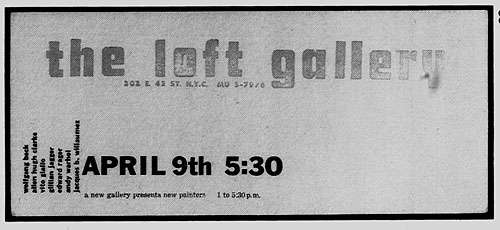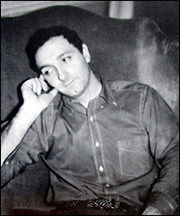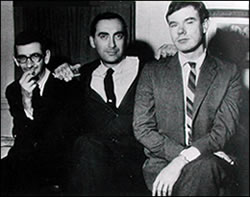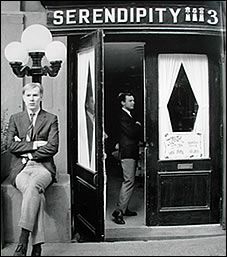Andy Warhol Pre-Pop
by Gary Comenas (2006)
page five

Announcement of the opening of the Loft gallery
(Courtesy of Thomas Kiedrowski of The Andy Warhol Sites Tour)
During 1954 Warhol exhibited his work at the Loft Gallery at 305 East 45th Street. (1) The gallery opened on April 9th with a group show that included Warhol. The gallery manager, Vito Giallo would later work as Warhol's commercial art assistant briefly during 1958/59.(2)

Vito Giallo
(Photographer unknown, ca 1959)
Vito Giallo:
"In the '50s, I worked for this well-known graphic designer, Jack Wolfgang Beck. I was his only assistant. Jack had this long loft studio on East 49th Street between First and York... We had all this extra space - we just needed a small room to do our work. So Jack said, 'What can we do with this space?' I said, 'Well, what about an art gallery?' He liked the idea, and we decided to call it the Loft Gallery. Jack rented the space, and he let me run the gallery. So I got myself, Jack, Nathan Gluck, and his friend Clint Hamilton to show work at the gallery. And then Nathan said, 'Well, let's have Andy.' And I said, 'oh great.' So Andy exhibited with us as well. We were all illustrators but we wanted to be fine artists. Actually, that's one of the comments that the famous critic who was also a painter, Fairfield Porter, made when he came and reviewed our first group show. He was very nice, and he stayed for about an hour. But then when the review came out he said we were just a bunch of commercial artists who wanted to be painters." (3)
Andy Warhol exhibited at the Loft at least three times - two group shows that opened on April 9, 1954 and May 17, 1954 and a solo show that opened on October 10, 1954. In Andy Warhol's New York, Thomas Kiedrowski describes Warhol's contribution to the first show as an installation of pyramidal shapes that had fallen to the floor. That description was applied to "Andy's second show" at the Loft during an interview with Vito Giallo in Unseen Warhol, in which the pyramidal shapes were referred to by the interviewer as as Warhol's "Origami" show. (UW20) According to Giallo in Unseen Warhol, the April group show featured Warhol's "pen and ink line drawings, all simple, all outlines" that "were just pinned up to the wall, about eight by ten inches, nothing framed at all" which incorporated Warhol's "blotting technique." Giallo recalled in the Unseen Warhol interview that the 'origami' show was Warhol's second show at the Loft and was his first solo show at the gallery.
Vito Giallo (Unseen Warhol):
He [Andy Warhol] didn’t call it Origami at all. But that’s the best description of it. He would start with a square piece of paper. He would take the paper, and then he would fold it, and somehow he got a lot of pyramids out of it. Then he would open it up one way or another, and some pyramids would be sticking out. Next he would do drawings of heads and people on parts of the pyramids, and he did a lot of marbleising, oil on water. Finally, he’d hang them up so that they were sticking out from the wall. We used pushpins to hang them up, and they kept falling down; I must have picked those pieces up a hundred times.
I think he threw them all out. He never sold anything at the gallery. Very few of us did. But I know nobody even looked at this show. I thought it was fascinating. I was amazed. It was his turn to do a one-man show, and I thought it would be drawings and paintings, something straightforward. And then those things came in. I was just shocked.’ (UW22)
Thomas Kiedrowski (Andy Warhol's New York):
Artist Vito Giallo appropriated the front room of Jack Wolfgang Beck's large loft space here to hold art exhibits beginning in 1954. Giallo, along with his friends Nathan Gluck and Clint Hamilton, deliberated over who should be invited to be part of the gallery. They decided to ask Andy Warhol to join the collective.
The first show opened on April 9 with seven artists: Beck, Giallo, Jacques B. Willaumez, Edward Rager and three Carnegie Tech alumni: Allan Hugh Clarke, Gillian Jagger, and Andy Warhol. Warhol's work resembled more of an installation than a show of traditional paintings. He drew small figures on pieces of marbled Strathmore paper, then folded them into large pyramidal shapes. The ten or so works were pinned to the wall, but the weight made them fall to the ground more often than not. Reviewers nicknamed the works 'crumpled' drawings, after repeated falling and re-pinning.
On May 17, Warhol was part of a group show including Allan Hugh Clarke and Edward Rager, but this time he illustrated poems and hung them in a conventional manner. They reminded one reviewer of unrefined imitations of Jean Cocteau drawings.
Warhol's last show at the Loft would be his first solo New York show, opening October 10, 1954, and featuring drawings of the famous dancer John Butler. Giallo remembers that they were astounded when John Butler came to the show. The dancer received several drawings from Warhol in 1954.
By the summer of 1955, the Loft Gallery would closed, ending with a show of collages by Clint Hamilton. Giallo, who had managed the gallery , immediately started to work for Warhol... After Giallo left the job in 1956, Warhol employed Nathan Gluck as an assistant until the mid-sixties, paying him the minimum wage as he did with Giallo and later paid assistants. (TKA79, 86)
According to Nathan Gluck the papers were meant to be on the floor. He recalled that Warhol "sort of placed them around... You sort of walked up and said, 'Where's the show?'" (6)
Nathan Gluck:
"Andy had taken paper. I can't remember if he drew on it or what, and, then he would fold it every which way, and they were just stuck around on the floor... I remember just: 'Oh, crumpled paper! God! Andy, do you think anybody will buy that?' And when you stop and think about it today, it's like Carl Andre and the Earth [Art] people and the Minimalists and everything." (7)
Gluck recalled that he taught Warhol the process of marbleisation.

Nathan Gluck (center) with Andy Warhol
(Photo: Edward Wallowitch)
Nathan Gluck:
"I taught him [Warhol] how to marbleise paper. All you do is sprinkle thinned-out oil paint on water and then lay paper down on top of it or simply immerse it. And that's marbling; except when you want a very definite pattern, you use a solvent that can hold the pattern... Andy did these strange marble things, and then he crumpled them up and just left them around on the floor... I thought Andy had installed them on the floor. Well, maybe by the time you came to see the show it was all on the floor. Andy had a very informal approach to a lot of things, and I think that approach carried on throughout his career. The blotting technique was basically a forerunner of silkscreen - in other words, he moved from one kind of a multiple to a more professional multiple." (8)
JOHN BUTLER DRAWINGS
Warhol's third and final exhibit at the Loft Gallery were drawings of the dancer, John Butler.
Vito Giallo:
Well, Andy's third show was in fact all drawings - of John Butler, the dancer. John came to see the exhibit; very few people did. But I remember John coming and I thought, 'Oh, my god, John Butler!' I was so excited because I liked his work so much. And the whole room was nothing but drawings of him. I think they were from memory. Dance poses, portraits. (9)
Warhol did not sell anything at these exhibitions. However, while his Pre-pop fine art career faltered, he became increasingly successful as a commercial illustrator. In 1955 he became the sole illustrator for I. Miller & Sons Shoes, receiving a substantial retainer. It was also in 1955 that he probably started wearing a wig.
Carlton Willers, who originally met Warhol in 1953, recalled the artist's appearance, both 'pre' and 'post' wig.
Carlton Willers:
"I got to [know] Andy quite well, and he always looked bedraggled: always had his tie lopsided, as he didn't have time to tie it, and he never tied his shoe laces, and he even wore different coloured socks, but he bought all of his clothes at Brooks Brothers. And he always wore a hat - a cap. And he always wore it because he was very self-conscious about going bald, and he'd even wear it at dinner parties. I'd tell him to get a hairpiece, and he finally did... oh, around '55, and it made him look younger. He was acutely self-conscious of himself... He thought that he was totally unattractive. He was very bald. He was quite prematurely gray, and he had a rather large nose. He had plastic surgery on [it], sanded the nose and corrected it, but it was still rather bulbous. His first hairpiece was light-brownish with some gray, and he suddenly experimented with a lot of them. If he had one of something and liked it, he would buy a lot of whatever it was. He bought the stereotypical Brooks Brothers business suit, but when he wore it, it was all askew. It was calculated, and charming. He was very boyish, and I think people like this." (10)
Warhol's friend Charles Lisanby also recalled that by the time he and Andy went to the Far East in 1956, Andy was "even then" wearing a wig. (MK)
By hiring Warhol as their sole illustrator, I. Miller was attempting to modernize their image through innovative graphic design. According to Geraldine Stutz, I. Miller's vice-president at the time, it was the start of an era when one "sold the sizzle and not the steak." (11) I. Miller was not just selling shoes, they were selling a lifestyle. As with Tina S. Fredericks who hired Warhol for one of his first assignments in New York, Stutz had previously been the art director for Glamour magazine before becoming head of the retail division of I. Miller. Warhol worked for I. Miller until 1957 when the store was bought by Genesco, Inc.(12)
Geraldine Stutz:
"I. Miller was a beautiful old name, fashion name, in shoes. Probably the most recognizable name in shoes... and shoes are synonymous with I. Miller. That was a reputation that had been built by 'old' I. Miller, whose name was Israel, Ivan Israel... who was a theatrical shoe maker with enormous flair for promotion. He had built this name so that it was interchangeable with shoe fashion in this country... it was a successful business, and the name was magic, but it had got a little old-hat, a little passé... slightly over-the-hill. The campaign that Peter [Palazzo] designed and that Andy was the artist [for]... made an enormous difference in how the name 'I. Miller' was perceived by women. It made it contemporary, up-to-date." (13)
According to I. Miller's art director, Peter Palazzo, Warhol was hired after another illustrator, Bob Gill, left the company. (14) Warhol did the drawings for the retail ads only which were mostly used for the Sunday edition of the New York Times, although they also occasionally appeared in the New York Herald Tribune and "rarely" in the New York News. The budget was limited and Warhol was contracted to do a designated amount of ads for a specific fee. Deadlines were generally 2 or 3 days to a week and sometimes even a day or a few hours. (15) Warhol was, as Tina S. Fredericks previously characterized him, "an art director's dream come true." (16) He was not precious about his work, making whatever changes were required in a short space of time.
The I. Miller ads were modern and innovative, featuring stylised versions of their shoes rather than facsimile reproductions. Repetition was sometimes employed to emphasize a product. One advertisement, proclaiming "the well-heeled look on fashion" featured Warhol's drawings of heels repeated across the ad, similar to the repetition he later employed in works such as 100 Cans and S & H Green Stamps. Sometimes the ads didn't include shoes at all. A Happy Easter advertisement featured a Warhol drawing of a single lily. An ad inviting the reader to visit the Shoe Salon at Henri Bendel featured roughly printed alternate black and white stripes - the Bendel trademark. Warhol's stripes were roughly drawn and the imperfections maintained in the ad.
Warhol would usually present a selection of different drawings to I. Miller and they would choose which ones to use. He sold the unused drawings at Serendipity 3, a cafe boutique which had opened in September 1954 at 234 East 58th Street by Stephen Bruce and Calvin Holt. (17) Warhol's financial records indicate that in 1957 he spent $1,900.95 at the cafe. (SC26) In 1958 the cafe moved to larger premises at at 225 East 60th Street.

Andy
Warhol and Stephen Bruce
at the second Serendipity 3 (1962)
(Photo: John Ardoin)
Stephen Bruce:
"He [Andy Warhol] had an entourage of boys constantly. He wore a tweed jacket usually, with a white shirt, a knit tie, dungarees and loafers. Then he came in many times with Charles [Lisanby]. He [Warhol] would come in with all the sketches he did for I. Miller Shoes... We would look at his work and he'd say, 'Oh, they liked this' or 'they didn't like this' or 'they picked the wrong one.' And so I got the idea... I said, 'Let's frame them and we can sell them.' So that's how it started. We sold them for $15 and $25. I framed them for more. So he started doing them with colour. We were Andy's first "Factory." He'd bring in these four or five guys and he had pens and inks on the table, and then he would do the butterflies on the shoes and watercolours. Those were all done at Serendipity." (18)
Nathan Gluck recalled that Andy also later sold some of his drawings at another shop on Madison Avenue:
Nathan Gluck:
"... occasionally, he had a lot of the drawings around the house that had been tinted with watercolour and there was a lady on Madison Avenue... Her name was Joan Morse, and she ran a little shop called The Gilded Lily. So, very often, we used to refer to her as 'The Gilded Lily lady,' and Andy would sometimes take these drawings down to her and stick them in the window and try to sell them in her shop, and it had all sorts of little chic things, boutique-type things, and, of course, at that time it was quite an innovation. And she had some of Andy's things on consignment." (19)
BILLY NAME
Warhol would continue to visit Serendipity throughout his life and later conducted some interviews at the cafe for Interview magazine. In approximately 1959 he met a young waiter there who would later become the person responsible for the silver look of the first "Factory": Billy Name. At the time, Billy was still using his birth name, Billy Linich. On May 25, 1963, the artist Ray Johnson took Billy to the Mr. New York Contest and Variety Show at the Brooklyn Academy of Music which Warhol also attended and it was after the BAM show that Billy "started hanging with Andy." (20) According to Billy, Ray Johnson "used to visit me at Serendipity with Dorothy Podber, and he was working with Andy doing covers for New Directions paperbacks." (21) Podber would later become famous as the woman who shot several of Warhol's Marilyns with a pistol in the autumn of 1964. (22) Although Warhol and Linich had a brief sexual fling, they became friends rather than lovers. Billy had hair cutting parties at his apartment and at the end of 1963, Warhol shot several films of Billy cutting hair. Although Popism has Linich meeting Warhol at the San Remo Coffee Shop, Billy does not recall ever seeing Warhol there - although he is "pretty sure" he met other 60's stalwarts there, including Dorothy Podber, Nick Cernovich, Ray Johnson and Robert Heide. (23) Billy went to the San Remo every friday and saturday night with a fellow waiter from Serendipity - Ron Link. Link would later become known as a director of off-Broadway plays, including a production of Glamour, Glory and Gold by Warhol star, Jackie Curtis.